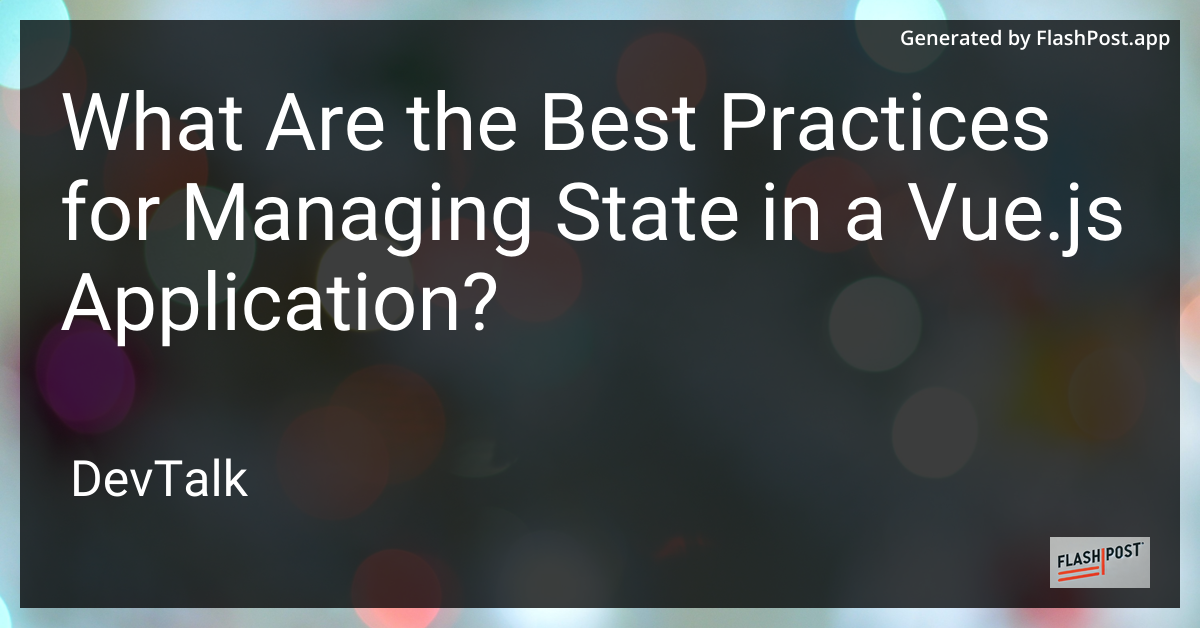What Are the Best Practices for Managing State in a Vue.js Application?

Best Practices for Managing State in a Vue.
js Application
Managing state in a Vue.js application can be crucial for maintaining a responsive, predictable, and scalable application. In this guide, we'll cover best practices that developers can follow to effectively manage state in their Vue.js applications. Proper state management ensures that your application runs smoothly, is easier to debug, and scales well as it grows.
1. Use Vuex for Centralized State Management
Vuex is the official state management library for Vue.js, which allows you to manage the state of your application in a centralized store. This makes it easier to track state changes and debug issues. It’s especially beneficial in medium to large applications where shared state logic can become complicated.
Key Benefits of Using Vuex:
- Centralized Store: Keeps the state in one place for a more organized codebase.
- Predictable State Mutations: State changes occur in a consistent manner using mutations.
- Time Travel Debugging: Easily track when, where, and why the state changed using Vue Devtools.
2. Modularize the Store
When your application grows, it's important to keep your Vuex store manageable. Breaking down your store into smaller modules can help organize and maintain it more efficiently. Each module can contain its own state, mutations, actions, and getters, making it reusable and contextually relevant in particular parts of your application.
3. Use Local State Where Appropriate
Not all state needs to be stored in Vuex. Use Vuex for global state that is shared across multiple components. For state that is specific to a single component or a small part of your application, consider using local state. This can simplify your code and make your application easier to maintain.
4. Leverage Vue Composition API for Flexible State Management
With the introduction of the Composition API, Vue 3 allows for more flexible and logical grouping of related stateful logic without the limitations of the Options API. This approach can be especially beneficial for managing complex states and sharing stateful logic across components.
5. Implement Vue Router for State Management Related to Navigation
Managing navigation and component state can be elegantly handled using Vue Router. It allows for passing props between routes which can streamline state management in routed components.
6. Validate and Control Component State
Ensure data integrity and control user inputs with proper validation strategies. Utilizing validation techniques can help maintain consistent and expected application behavior. For instance, you can explore how to validate numeric inputs using Vue.js number input validation.
7. Keep UI State separate
The application's UI state, like whether a modal is open or which tab is selected, should usually be managed within component local state rather than Vuex. This keeps your Vuex store focused on the data that reflects the app's overall state rather than per-component data.
8. Use iFrames Judiciously
Managing state when dealing with iframes requires attention. If you need to update or refresh iframes, consider strategies discussed in these articles - Updating iframes in Vue.js and Refresh iframe in Vue.js.
9. Optimize Performance with Lazy Loading
For larger applications, performance can become an issue. Using lazy loading to manage how and when state is fetched and using techniques such as component lazy-loading can mitigate potential performance bottlenecks.
10. Use Watchers and Computed Properties for Efficient State Management
Watchers and computed properties are powerful tools in Vue.js that enable you to reactively manage state changes and derive new states efficiently. Computed properties can cache data based on reactive dependencies, while watchers can perform side effects in response to specific state changes.
By incorporating these best practices into your Vue.js application, you can ensure robust and efficient state management, leading to more maintainable and scalable applications. For more advanced handling of state in editors, explore the Vue.js editor autofocus guide.